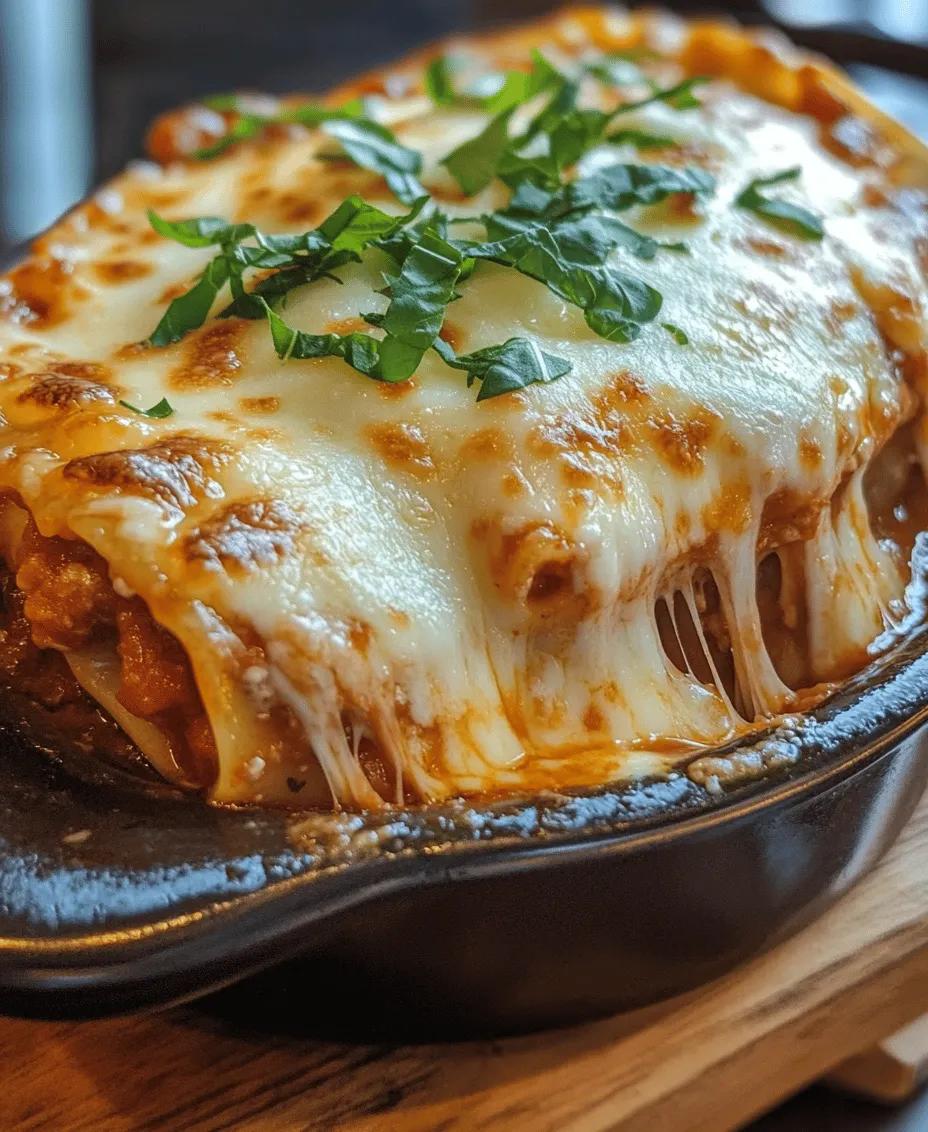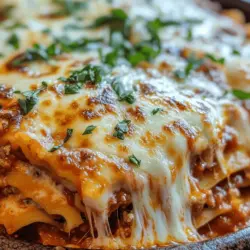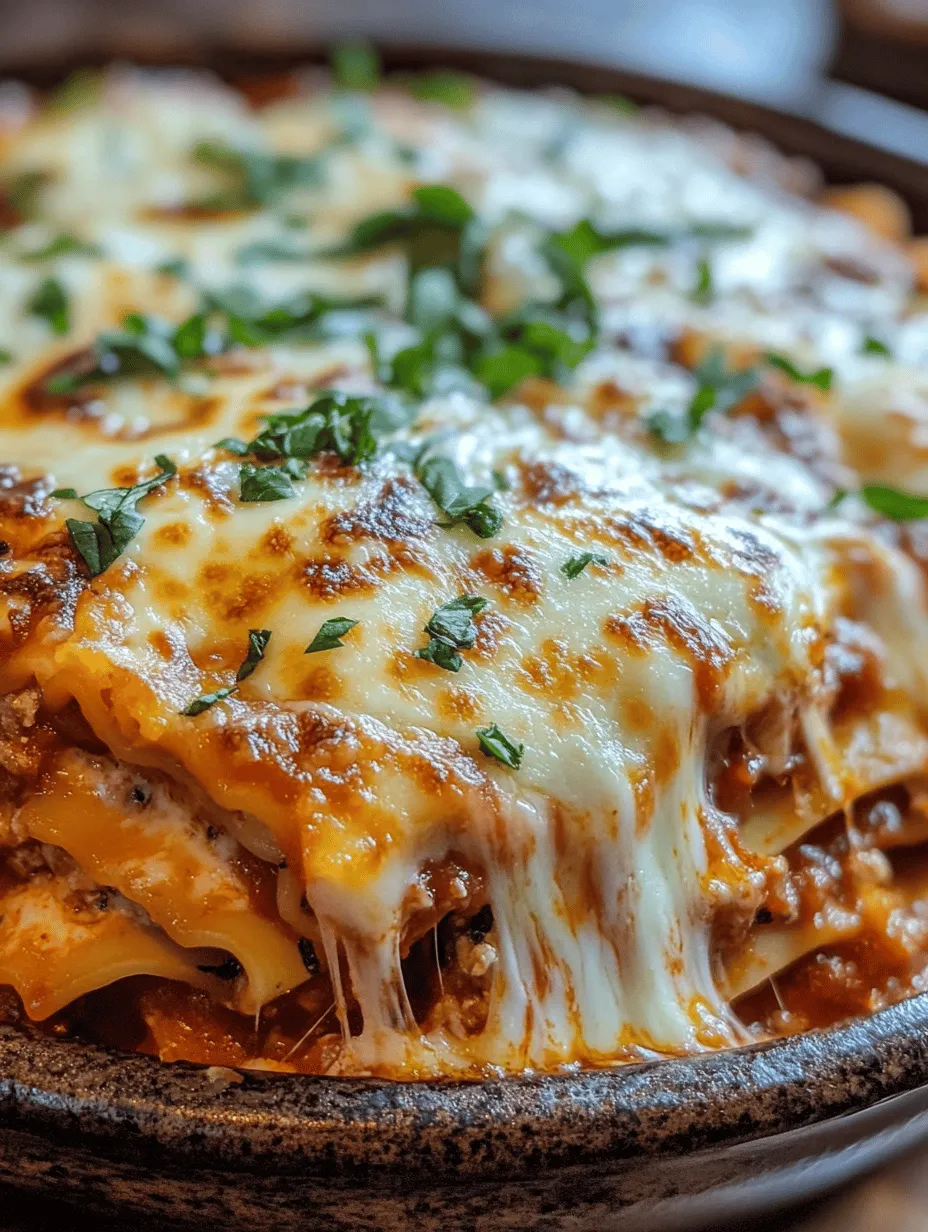Introduction
Lasagna is one of those classic dishes that evokes feelings of warmth and nostalgia. With its rich flavors and satisfying layers, it has earned its place as a beloved comfort food across many cultures. The beauty of this Easy Homemade Lasagna Recipe lies in its simplicity, making it accessible for anyone who craves this Italian delight without the fuss often associated with traditional preparation. Whether you are a seasoned home cook or a novice in the kitchen, this recipe invites you to create a delicious lasagna that can easily become a staple in your meal rotation.
What makes this lasagna particularly appealing is its versatility. You can customize the ingredients to suit various dietary preferences, whether you are looking for a meat-laden masterpiece, a vegetarian option, or even a gluten-free version. This adaptability, combined with straightforward instructions, ensures that this lasagna will cater to everyone at the dinner table.
Understanding Lasagna: A Culinary Delight
Lasagna has a rich history that traces back to ancient times in Italy, making it a dish steeped in culinary tradition. The word “lasagna” is derived from the Greek word “laganon,” which referred to strips of pasta dough. Over the centuries, this dish has evolved, with each region of Italy contributing its unique twist. The classic lasagna consists of layers of pasta, meat, cheese, and sauce, all baked together to create a harmonious blend of flavors and textures.
As lasagna traveled beyond Italy’s borders, it adapted to local tastes and ingredients, resulting in numerous variations worldwide. For instance, in the United States, lasagna often features a hearty meat sauce, while in other countries, you might find versions that include vegetables, seafood, or even different types of cheese. Regardless of the variation, lasagna remains a favored dish for family gatherings, potlucks, and special occasions, bringing people together over shared plates of comfort food.
The preparation of lasagna is not just about assembling ingredients; it also embodies the joy of cooking and sharing food with loved ones. The process often becomes a family affair, with everyone contributing to the layers—whether it’s boiling the noodles, mixing the cheeses, or spreading the sauce. This communal aspect of lasagna-making is one of the reasons it holds such a special place in many hearts.
Essential Ingredients for Homemade Lasagna
Creating the perfect lasagna begins with understanding the essential ingredients that come together to create this iconic dish. Each component plays a crucial role, contributing to the overall flavor profile and texture. Let’s delve into the key ingredients you’ll need for this Easy Homemade Lasagna Recipe:
Lasagna Noodles
The foundation of lasagna lies in the noodles, and selecting the right type can significantly impact the dish’s texture. You have two primary options: traditional lasagna noodles that require boiling before layering or no-boil lasagna noodles that can go directly into the dish.
– Traditional Lasagna Noodles: These are typically made from flour and eggs, resulting in a slightly chewy texture when cooked properly. Boiling them before assembling allows for greater control over their doneness, ensuring they don’t become mushy during baking.
– No-Boil Lasagna Noodles: A convenient alternative, these noodles are designed to soften during the baking process. They absorb moisture from the sauce, which can lead to a different texture but saves time in preparation.
Choosing between these types depends on your preference for convenience versus traditional texture. Regardless of which you choose, ensure they are layered evenly in your lasagna for the best results.
Ground Meat
The choice of ground meat significantly influences the flavor of your lasagna. While ground beef is a popular choice for its robust flavor, many recipes also incorporate Italian sausage for a spicier kick. The combination of these two can create a rich, savory filling that elevates the dish.
– Ground Beef: This is the classic choice, offering a hearty flavor that pairs well with marinara sauce. Opt for a leaner variety to reduce excess grease.
– Italian Sausage: This option is seasoned with spices like fennel and garlic, adding a depth of flavor that complements the other components. You can choose sweet or hot sausage depending on your taste preference.
Feel free to experiment with different meats, or even substitute with ground turkey or plant-based options for a healthier or vegetarian lasagna.
Onion and Garlic
Aromatics like onion and garlic are essential for building a flavorful base in your lasagna. Sautéing diced onions until translucent and adding minced garlic creates a fragrant foundation that enhances the overall taste of the meat sauce. These ingredients not only add depth but also contribute to the comforting essence of the dish.
Ricotta Cheese
Ricotta cheese is a hallmark ingredient in lasagna, known for its creamy texture and mild flavor. It serves as a filling that adds richness between the layers. When mixed with an egg and herbs, ricotta becomes a luscious filling that complements the other cheeses in the dish. It also acts as a binding agent, helping to hold everything together while creating a smooth, creamy texture.
Mozzarella and Parmesan
Cheese lovers rejoice! Mozzarella and Parmesan are the stars of the cheesy layers in lasagna.
– Mozzarella: Known for its excellent melting qualities, mozzarella creates that gooey, stringy texture that many people crave in a lasagna. Using fresh mozzarella can elevate the dish, providing a creamier texture and more pronounced flavor.
– Parmesan: This hard cheese adds a salty, nutty flavor that enhances the overall taste profile. Sprinkling Parmesan on top before baking creates a beautifully golden and crispy crust.
Marinara Sauce
The sauce is crucial in tying all the components together. You can opt for store-bought marinara for convenience or whip up a homemade version for a personal touch.
– Store-Bought Marinara: Easy and quick, many brands offer high-quality sauces that can save you time in the kitchen. Look for options with natural ingredients and minimal preservatives for the best flavor.
– Homemade Marinara Sauce: Making your own sauce allows you to customize the flavors to your liking. Simple ingredients like crushed tomatoes, olive oil, and herbs can be simmered together to create a rich, flavorful sauce that elevates your lasagna.
Egg and Herbs
Adding an egg to the ricotta mixture serves two purposes: it binds the filling together and adds richness to the overall dish. Fresh or dried herbs like basil and oregano can also be mixed into the ricotta for an extra layer of flavor that complements the marinara sauce.
Seasoning
Simple seasoning is essential to balance the flavors of your lasagna. Salt and pepper are fundamental, but don’t overlook the importance of adding dried herbs. Oregano and basil are traditional choices that can enhance the flavor profile and provide that quintessential Italian taste. Adjust the seasoning according to your personal preference, ensuring that each layer is well-seasoned for a deliciously satisfying meal.
Step-by-Step Instructions for Assembling Lasagna
Now that you’ve gathered all the essential ingredients, it’s time to dive into the step-by-step process of assembling your Easy Homemade Lasagna. Following these detailed instructions will ensure each layer is perfectly constructed for optimal flavor and texture.
Preheating the Oven
Before you start assembling your lasagna, it’s crucial to preheat your oven to the correct temperature—typically around 375°F (190°C). Preheating is essential for even cooking and ensures that your lasagna bakes properly, allowing all the flavors to meld together beautifully. While your oven heats up, you can prepare the other components of the dish, making the process more efficient.
As we move forward, each step will guide you through creating a delicious homemade lasagna that’s sure to impress family and friends alike. Whether you’re planning a cozy family dinner or a gathering with friends, this dish is versatile enough to fit any occasion. Stay tuned for the following sections, where we will explore the detailed assembly process and additional tips for perfecting your lasagna.

Cooking the Noodles
To achieve the perfect texture for your lasagna, it is crucial to cook the noodles properly. Begin by bringing a large pot of salted water to a rolling boil. Use about one tablespoon of salt for every four quarts of water. This will not only season the noodles but also enhance their flavor.
Add the lasagna noodles and stir gently to prevent them from sticking to one another. Cook the noodles according to the package instructions, typically around 8 to 10 minutes, until they are al dente—meaning they should be firm to the bite. Overcooking can lead to mushy layers, which can ruin the overall texture of your lasagna.
Once cooked, drain the noodles and rinse them under cold water. This halts the cooking process. Lay the noodles flat on a clean kitchen towel or parchment paper to prevent them from sticking together while you prepare the rest of the ingredients.
Preparing the Meat Mixture
Next, let’s prepare the meat mixture, which provides the rich, savory flavor that is a hallmark of traditional lasagna. Start by heating a large skillet over medium heat. Add a drizzle of olive oil and then introduce your ground beef and Italian sausage (if using). Using a wooden spoon, break the meat apart and cook until it is browned and no longer pink, about 7 to 10 minutes.
Once the meat is fully cooked, be sure to drain any excess fat. This step is crucial for avoiding a greasy lasagna. You can do this by carefully tilting the skillet and using a spoon to scoop out the fat, or by draining the meat mixture in a colander. After draining, return the meat to the skillet and add your chopped onion and minced garlic. Sauté for an additional 2-3 minutes until the onion is translucent and fragrant.
Next, add your crushed tomatoes, tomato paste, Italian seasoning, salt, and pepper to the skillet. Stir everything together and let the mixture simmer for about 15 minutes on low heat. This allows the flavors to meld beautifully.
Mixing the Ricotta
While the meat mixture simmers, it’s time to prepare the ricotta filling. In a medium bowl, combine 15 ounces of ricotta cheese, one beaten egg, a pinch of salt, and a handful of freshly chopped parsley or basil. Mixing an egg into the ricotta not only adds richness but also helps bind the filling, making it easier to layer in the lasagna.
To achieve a smooth consistency, use a hand mixer or fork to blend the ingredients until well combined. If you like a hint of flavor, consider adding grated Parmesan cheese or lemon zest. This will elevate the ricotta filling and add an extra layer of taste to your lasagna.
Layering Techniques
Layering your lasagna correctly is essential for both flavor and texture. Begin by spreading a thin layer of the meat sauce on the bottom of a 9×13-inch baking dish. This helps prevent the noodles from sticking. Next, place a single layer of noodles over the sauce, slightly overlapping them if necessary.
Follow with a generous layer of the ricotta mixture. Use a spatula to spread it evenly, making sure to cover the noodles completely. Then, add another layer of meat sauce on top of the ricotta, followed by a sprinkle of mozzarella cheese. Repeat these layers—noodles, ricotta, meat sauce, and mozzarella—until you reach the top of the dish. Your final layer should consist of noodles covered with the remaining meat sauce, a generous sprinkle of mozzarella cheese, and a dusting of grated Parmesan for a beautiful golden finish.
Covering and Baking
Before placing your lasagna in the oven, cover the baking dish tightly with aluminum foil. This step is vital as it traps moisture, allowing the lasagna to steam and cook evenly. Bake the lasagna in a preheated oven at 375°F (190°C) for 25 minutes.
After 25 minutes, carefully remove the foil and continue to bake for an additional 15 to 20 minutes, or until the cheese is bubbly and golden brown. This uncovered baking allows the cheese to develop a delicious crust while the flavors continue to meld together.
Cooling and Serving
Once your lasagna is out of the oven, resist the temptation to dive in immediately. Allow it to cool for at least 15 minutes before slicing. This resting period is crucial as it helps the layers set, making it easier to cut neat portions. If you slice too soon, you risk a soupy mess on your plate.
When ready to serve, cut your lasagna into squares and pair with a simple side salad or garlic bread for a complete meal. The comforting aroma of homemade lasagna is sure to draw everyone to the table.
Nutritional Insights of Homemade Lasagna
Understanding the nutritional benefits of your homemade lasagna can enhance your appreciation of this classic dish.
Caloric Breakdown: A typical serving of homemade lasagna contains approximately 350 to 400 calories, depending on the specific ingredients used. This makes it a satisfying meal that can fit well into a balanced diet.
Protein Content: Lasagna is rich in protein, primarily from the meat and cheese. A serving can provide around 20 grams of protein, contributing to your daily requirements and supporting muscle health.
Vegetarian Variations: For those seeking a healthier alternative, consider substituting the meat with a variety of vegetables such as zucchini, spinach, or mushrooms. These options not only reduce calories but also add a wealth of vitamins and minerals.
Whole Grain Noodles: Opting for whole grain lasagna noodles can increase the fiber content of your dish, promoting better digestion and overall health. Whole grains are also linked to lower risks of chronic diseases, making them a smart choice.
Common Variations and Customizations
Homemade lasagna is incredibly versatile, allowing for numerous variations and customizations to suit different tastes.
Vegetable Lasagna: For a lighter option, consider making a vegetable lasagna. Layer in sautéed spinach, zucchini slices, or roasted mushrooms in place of the meat. This variation not only enhances the nutritional profile but also adds vibrant colors and flavors.
Cheesy Lasagna: Cheese lovers can indulge by adding extra layers of cheese—think ricotta, mozzarella, and Parmesan. This creates an irresistibly gooey texture that makes every bite delightful.
Gluten-Free Options: If gluten is a concern, gluten-free lasagna noodles are widely available and can be used as a direct substitute. Additionally, consider using zucchini noodles (zoodles) for a low-carb, healthy twist.
Different Sauces: While marinara sauce is a classic choice, experimenting with different sauces can yield exciting new flavors. Try using pesto for a fresh, herby taste or Alfredo sauce for a creamy, indulgent variation.
Conclusion
Homemade lasagna is more than just a dish; it’s a celebration of comfort, tradition, and creativity in the kitchen. This easy recipe not only provides a satisfying meal but also brings friends and family together around the table. The joy of layering ingredients and the anticipation of baking create a wonderful experience that is as rewarding as the meal itself.
Encourage your culinary creativity by experimenting with various ingredients and flavors. Whether you stick to the classic meat and cheese or opt for a vegetable-packed version, each lasagna can be a reflection of your taste and style. Embrace the tradition of lasagna-making in your kitchen, and enjoy the warmth and satisfaction it brings to every occasion.



